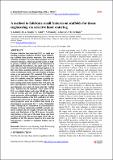| dc.contributor.author | Lohfeld, Stefan | |
| dc.contributor.author | Tyndyk, M.A. | |
| dc.contributor.author | Cahill, S. | |
| dc.contributor.author | Flaherty, N. | |
| dc.contributor.author | Barron, Valerie | |
| dc.contributor.author | McHugh, Peter | |
| dc.date.accessioned | 2013-09-24T14:11:15Z | |
| dc.date.available | 2013-09-24T14:11:15Z | |
| dc.date.issued | 2010 | |
| dc.identifier.citation | Lohfeld, S; Tyndyk, MA; Cahill, S; Flaherty, N; Barron, V; McHugh, PE (2010) 'A method to fabricate small features on scaffolds for tissue engineering via selective laser sintering'. Journal of Biomedical Science and Engineering, . | en_US |
| dc.identifier.uri | http://hdl.handle.net/10379/3664 | |
| dc.description.abstract | Purpose:Selective laser sintering (SLS) is a rapid prototyping technique applied to produce tissue-engineering scaffolds from powder materials. The standard scanning technique, however, often produces struts of extensive thickness, which means fabrication of highly porous scaffolds with small overall dimensions is quite difficult. Nevertheless, this study aims to overcome this shortfall. Design/methodology/approach:To this end, three scanning methods were evaluated in terms of minimum feature size and freedom of design, using a test polyamide (PA) material. Polycaprolactone (PCL) was then employed to create highly porous 3D scaffolds using the preferred scanning method to produce thin struts.Findings:While in normal scanning mode some features were well above the laser spot diameter, strut thicknesses below the laser spot diameter were achieved when using the outline scan function for PA material. Those achieved for PCL were slightly higher and in the 500-800 µm range, with an average pore size of 400 μm. Investigations on the properties of the scaffolds revealed an effective compression modulus of the PCL scaffold of 6.5 MPa. Furthermore, there was no change in physical or chemical properties when the scaffolds were stored in a physiological environment for 7 weeks. Originality/ value: Though SLS is considered as a fabrication technique for tissue engineering scaffolds, actually produced scaffolds did not comply with porosity requirements and limitations of the SLS process in producing features at the size of the laser beam spot have not been discussed. The present paper shows the capabilities of the SLS process based on two materials and presents a method to minimize feature size in scaffolds. | en_US |
| dc.format | application/pdf | en_US |
| dc.language.iso | en | en_US |
| dc.relation.ispartof | Journal of Biomedical Science and Engineering | en |
| dc.rights | Attribution-NonCommercial-NoDerivs 3.0 Ireland | |
| dc.rights.uri | https://creativecommons.org/licenses/by-nc-nd/3.0/ie/ | |
| dc.subject | Selective Laser Sintering | en_US |
| dc.subject | Rapid Prototyping | en_US |
| dc.subject | Scaffolds | en_US |
| dc.subject | Polycaprolactone | en_US |
| dc.subject | Tissue Engineering | en_US |
| dc.title | A method to fabricate small features on scaffolds for tissue engineering via selective laser sintering | en_US |
| dc.type | Article | en_US |
| dc.date.updated | 2013-09-13T15:48:14Z | |
| dc.identifier.doi | doi:10.4236/jbise.2010.32019 | |
| dc.local.publishedsource | http://dx.doi.org/10.4236/jbise.2010.32019 | en_US |
| dc.description.peer-reviewed | peer-reviewed | |
| dc.contributor.funder | |~|EU|~|IRCSET|~|PRTLI|~| | |
| dc.internal.rssid | 1328866 | |
| dc.local.contact | Stefan Lohfeld, Mechanical & Biomedical Eng, Engineering Building Eng-1042, Nui Galway. 2963 Email: stefan.lohfeld@nuigalway.ie | |
| dc.local.copyrightchecked | Yes | |
| dc.local.version | ACCEPTED | |
| nui.item.downloads | 585 | |


